Home / Introduction To Aromaticity
Aromaticity
Introduction To Aromaticity
Last updated: October 27th, 2022 |
What Is “Aromaticity”, Anyway?
In this post we introduce “aromaticity”, a term for describing a collection of three [Note 1] main properties that distinguish benzene from (hypothetical) cyclohexatriene.
- Extremely large resonance energy (36 kcal/mol)
- Delocalized electrons
- Undergoes substitution rather than addition reactions
[This collection of features is not unique to benzene. We’ll describe other aromatic molecules in the next post. See “Rules For Aromaticity“].
In the sections below we go through each of these three features in detail.
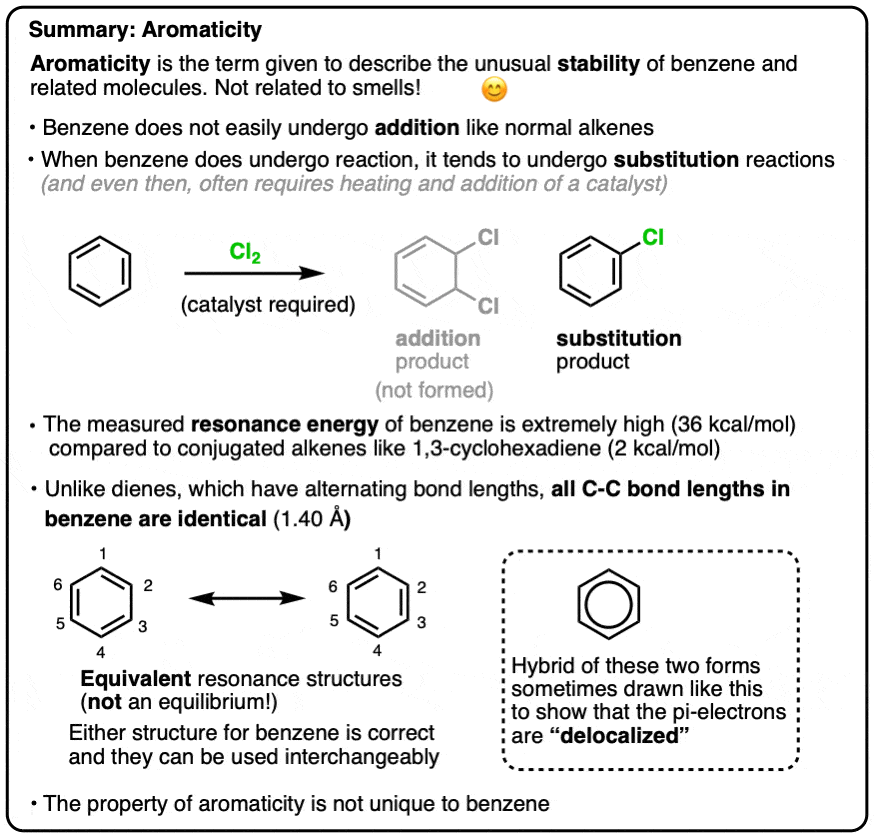
Table of Contents
- The Resonance Energy Of 1,3 Cyclohexadiene Is 2 kcal/mol
- The Resonance Energy Of “Cyclohexatriene” Is 36 kcal/mol (!WOW!)
- The “Emergent Property” Of Aromaticity
- The Structure of Cyclohexatriene Benzene And The “Delocalized” Nature Of Its Pi Bonds
- Benzene Undergoes Substitution Reactions, Not Addition Reactions
- This Collection of Three Special Properties Is Called “Aromaticity”
- Aromaticity Is Not Unique To Benzene
- So What Makes A Molecule Aromatic?
- Notes
- (Advanced) References and Further Reading
1. The Resonance Energy Of 1,3 Cyclohexadiene Is 2 kcal/mol
What’s “resonance energy” again? Let’s start with cyclohexene and build our way up.
In case you can’t picture it, cyclohexene is a six membered ring containing a single pi ( π)bond.
If you treat cyclohexene with hydrogen gas (H2) in the presence of a noble metal catalyst such as Pd supported on carbon (Pd/C), you form cyclohexane. The reaction liberates 28.6 kcal/mol (120 kJ/mol) of heat.
If you’re in second semester organic chemistry, there’s no doubt you’ve seen this reaction before.

Now for a slightly more interesting question. What happens to the enthalpy of hydrogenation when we add a second double bond adjacent to the first one: 1,3-cyclohexadiene. (There’s another isomer – 1,4 cyclohexadiene – which we won’t concern ourselves with for this example, because the double bonds are not conjugated).
The enthalpy of hydrogenation in this case is 55.2 kcal/mol (231 kJ/mol) ; almost, but not quite double of that for cyclohexene (2 × 28.6 = 57.2 kcal/mol).
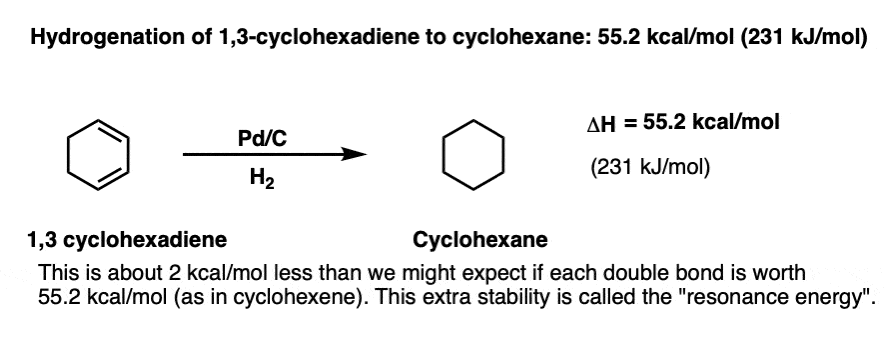
This is still an interesting result, because it tells us that having those two double bonds together results in a little bit of extra stability (2 kcal/mol) versus two isolated pi bonds.
We call this extra stabilization (2 kcal/ mol) “resonance energy” . It’s a consequence of conjugation – extending the p orbital overlap.
2. The Resonance Energy Of “Cyclohexatriene” Is 36 kcal/mol (!WOW!)
Finally, let’s move on to cyclohexatriene. What happens when there are three pi bonds in the ring?
We might naively expect the hydrogenation to liberate about (3 × 28.6 kcal/mol = 85.8 kcal/mol) of heat.
As it turns out, when we try to hydrogenate “cyclohexatriene” under normal conditions (Pd/C, room temperature 1 atm of H2), nothing happens. It’s inert.
Gradually we increase the heat and pressure. Still nothing happens. Cyclohexatriene refuses to hydrogenate.
Something strange is clearly going on here. Clearly, drastic measures are required.
In desperation, we march to the stockroom and break out the heavy artillery.
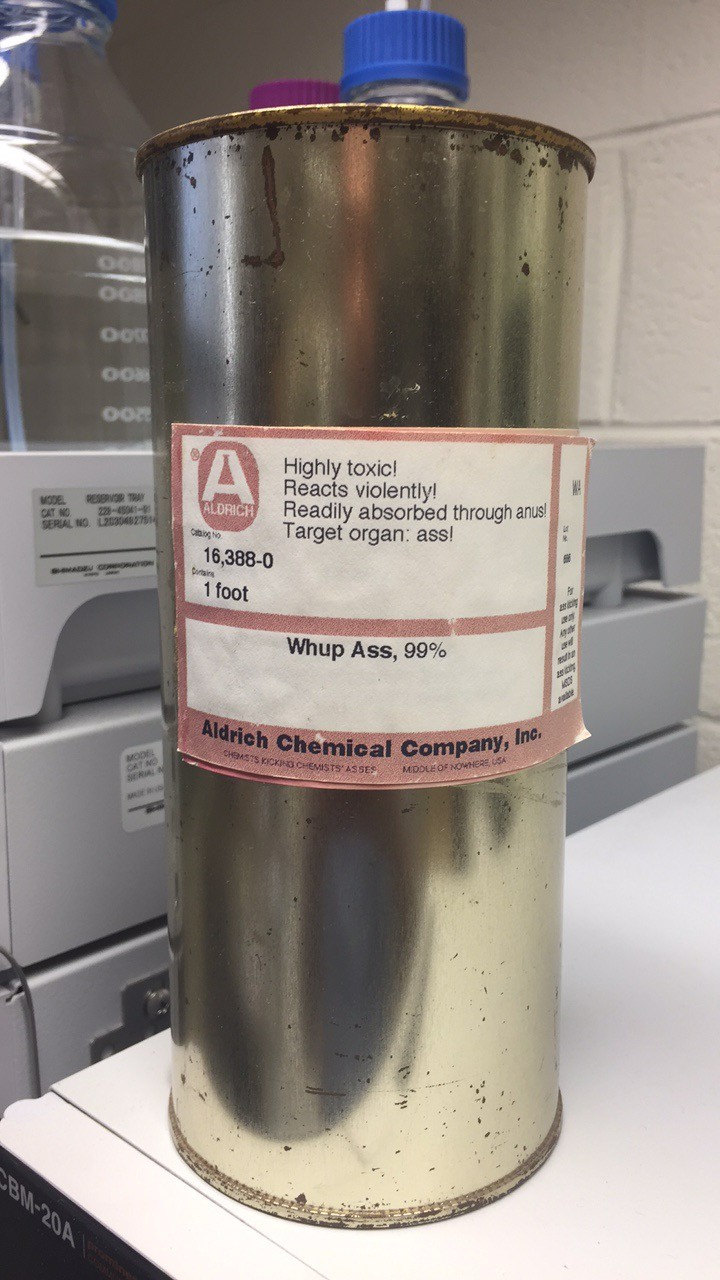
At 180-220°C and 25-30 atmospheres of hydrogen gas, “cyclohexatriene” finally succumbs to hydrogenation to give us cyclohexane.
The results of the enthalpy measurement are shocking. Recall that we expected the reaction to liberate 85 kcal/mol of heat.
In fact, the reaction liberates 49.8 kcal/mol (208 kJ/mol) of heat. Our guess was off by 36 kcal/mol.
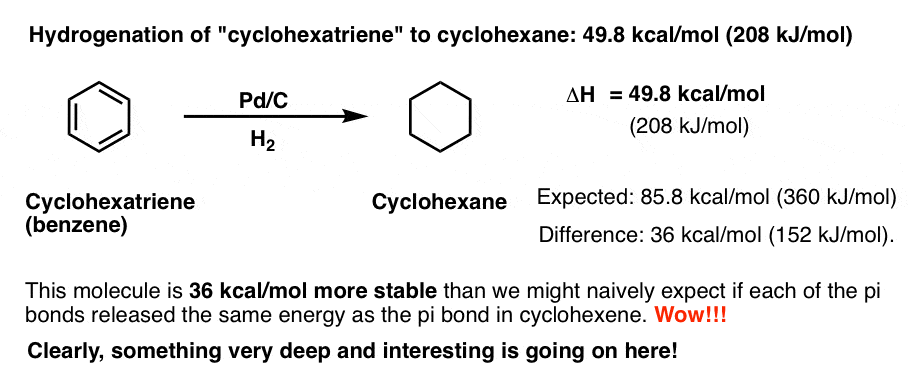
Hot Damn!
3. The “Emergent Property” Of Aromaticity
The heat liberated by hydrogenating cyclohexene and cyclohexadiene grew in roughly linear fashion, but adding that third double bond unlocked an important emergent property.
[We’re going to discuss this special property a lot in the next few posts in this series – it’s called “aromaticity” – but let’s not get too ahead of ourselves.]
First, it might help to take these energies and visualize them on a graph. Think of it as being a bit like standing on successive rungs of a ladder, with each “rung” representing a new pi bond. The “height above ground” corresponds to the energy released upon hydrogenation of the three successive molecules to the same final product (cyclohexane).
Going from the “second rung” (cyclohexadiene) to the ground state released almost twice as much energy than did going from the “first rung” to the ground state. It was about 3% less (2 kcal/mol) due to resonance energy.
We expected the “third rung” of our imaginary ladder to be another 26 kcal/mol or so higher up. In fact, the third rung is about 6 kcal/mol lower than the second rung.
Have you ever climbed a set of stairs with your eyes closed and, reaching the top, stumbled after your foot expected to land on a step that’s not there? It’s a lot like that.
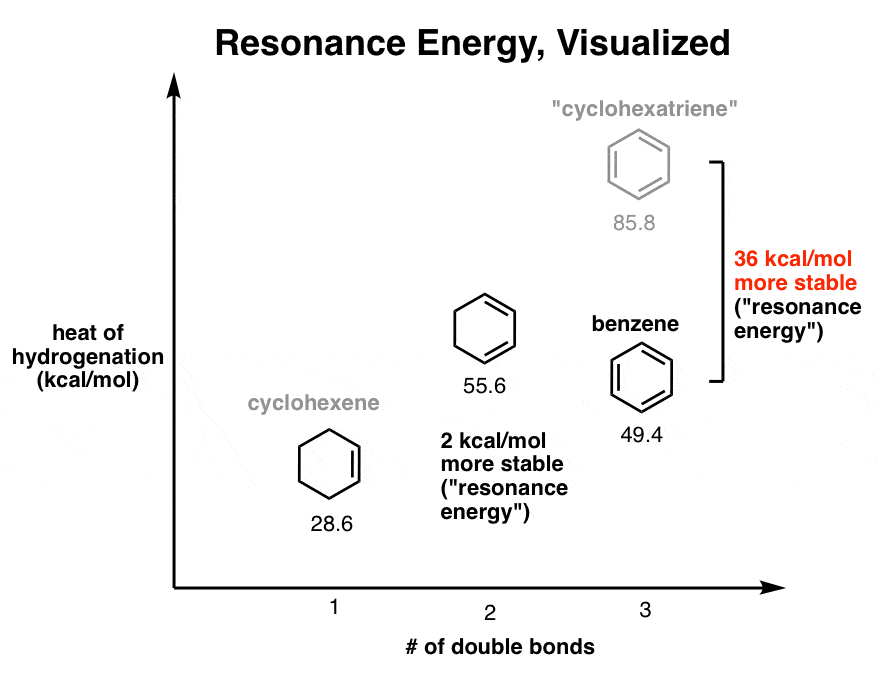
4. The Structure of Cyclohexatriene Benzene And The “Delocalized” Nature Of Its Pi Bonds
As you probably know by now, our “cyclohexatriene” actually goes by a different name: benzene.
Benzene has been known since at least the Middle Ages. Michael Faraday isolated it and originally determined its composition as C12H6 (later revised to C6H6 when the atomic mass of carbon was corrected) through burning a sample and measuring the samples of CO2 and H2O given off. Here is Faradays sample of benzene, which he named “bicarburet of hydrogen”.
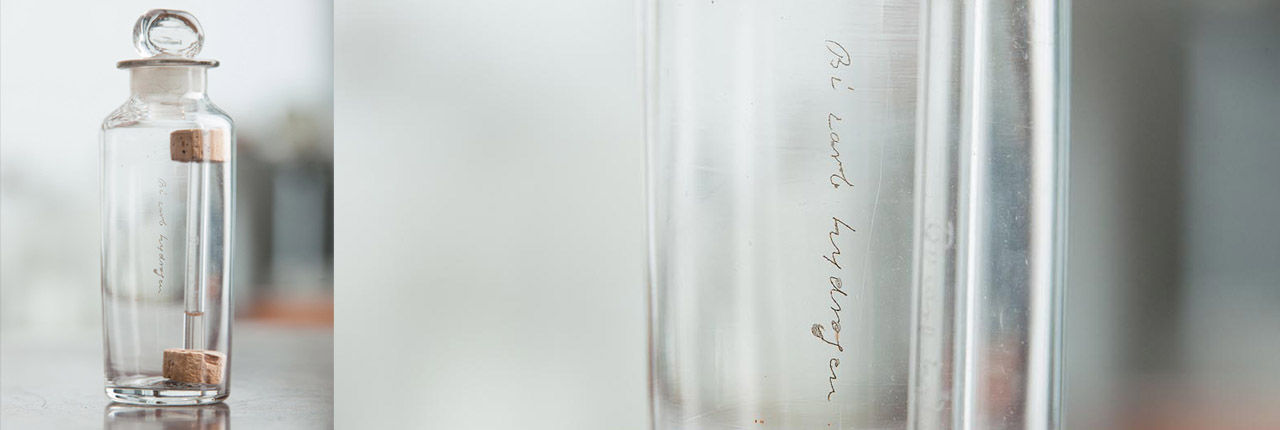
By the 1860s it was known that the molecular formula of benzene was C6H6, all of the hydrogens were equivalent, and that valence bond theory required that there be 4 bonds to carbon.
Many structures were proposed for this molecule. It fell to August Kekulé in 1865 to propose the correct, cyclic structure of benzene, which may or may not have been inspired by a dream about a serpent eating its own tail.
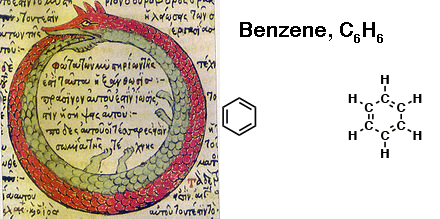
Something still bothered Kekule about this structure, however: disubstituted benzenes always seemed to be missing an isomer.
Take dichlorobenzene for example. From this structure, you’d expect 4 isomers: 1,2, 1,3, 1,4, and 1,6 (the difference between 1,2 and 1,6 is subtle, but they are different nonetheless).
The problem is that only 3 isomers of dichlorobenzene had ever been isolated and characterized.
Kekule’s solution to this problem was to propose that 1,2 dichlorobenzene and 1,6 dichlorobenzene interconvert too rapidly to allow for either to be separated.
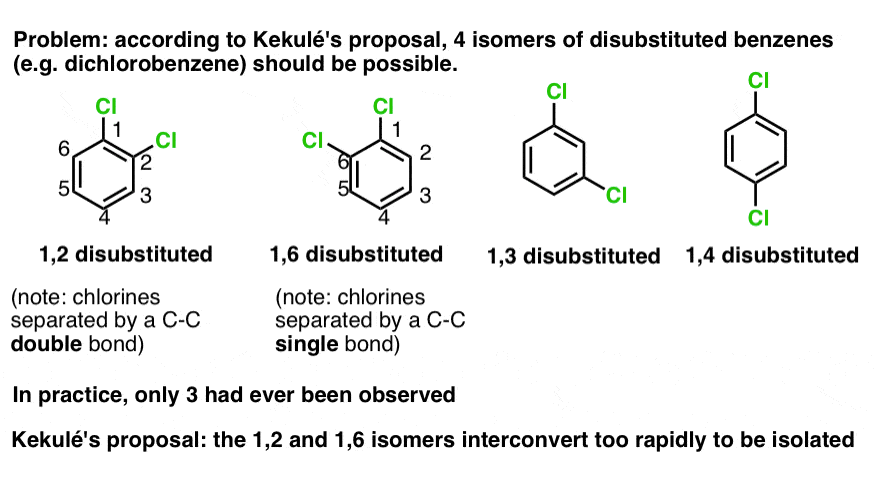
It wasn’t until X-ray crystallography was developed that this picture was shown to be incorrect. In 1928 Kathleen Lonsdale showed that all six C-C bond lengths in hexamethylbenzene were equivalent. She later determined the structure of benzene itself, which established the length of each C-C bond as 1.40 Å (140 picometers).
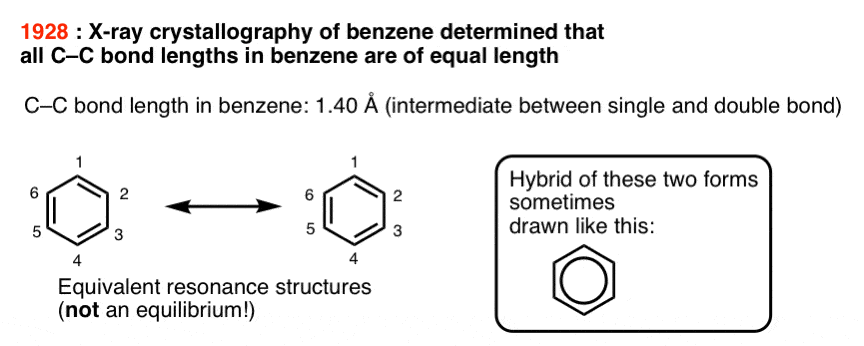
Equal bond lengths is inconsistent with two interconverting molecules.
Rather, it suggests that “1,2” and “1,6” dichlorobenzene are actually resonance forms of the same molecule and the “true” structure of benzene is a hybrid of these two structures.

One way of describing this is that the pi electrons in benzene are delocalized throughout the perimeter of the molecule, forming a kind of circle, or torus.

This is sometimes conveyed by drawing benzene as a hexagon with a circle in the middle.
5. Benzene Undergoes Substitution Reactions, Not Addition Reactions
Let’s go back to reactions.
We saw that benzene is a lot less reactive in hydrogenation reactions than what we’d expect from an alkene. In order for hydrogenation to occur, you have to subject it to tremendous heat and pressure.
You might reasonably ask: does benzene differ in its reactivity from alkenes in other ways as well?
You bet it does.
Here’s one of the most prominent differences.
As we’ve seen, alkenes typically react with electrophiles to give “addition” products (break C-C pi, form two new adjacent single bonds to carbon). Case in point: chlorination (see below).
Benzene is much less reactive toward chlorine than a typical alkene – it generally requires a catalyst in order for chlorination to occur (FeCl3 is a popular choice here). When it does react, instead of giving addition products, we instead see a substitution product (break C-H, form C-Cl).
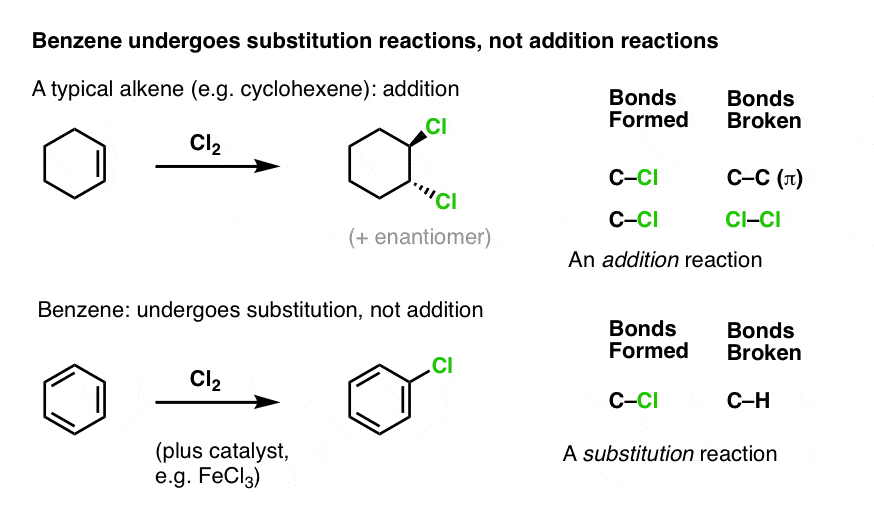
This turns out to be a very common class of reaction with benzene and its derivatives, a reaction we call “Electrophilic Aromatic Substitution”.
We’re not going to get into why this happens just yet. For now, lets just satisfy ourselves with the what.
More on that in a few posts.
6. This Collection of Three Special Properties Is Called “Aromaticity”
Let’s review the three* [Note 2 ] important properties we’ve noticed about benzene so far.
- Extremely large resonance energy (36 kcal/mol)
- Delocalized electrons
- Undergoes substitution rather than addition reactions
This collection of special properties has been known since the late 1800’s, and was given a special name that we are now stuck with: aromaticity. It actually has nothing to do with their aroma, although it was noticed that a number of sweet-smelling molecules all had these properties in common.
You might reasonably ask: is aromaticity unique to benzene and its derivatives?
7. Aromaticity Is Not Unique To Benzene
The answer is no – it turns out that aromaticity is such a fundamental and important property that it deserves its own chapter(s) in introductory textbooks, which is why we will be writing a whole series on this phenomenon.
Aromaticity is a property shared by a large number of molecules, including
- molecules with multiple rings (e.g. naphthalene, anthracene, indole)
- molecules with ring sizes other than 6
- molecules with rings containing atoms other than carbon (furan, indole, pyridine) [aromatic molecules containing an atom other than carbon are often called “heterocycles”].
- certain molecules bearing a positive charge (the “tropylium ion”)
- certain molecules bearing a negative charge (the “cyclopentadienyl anion”)
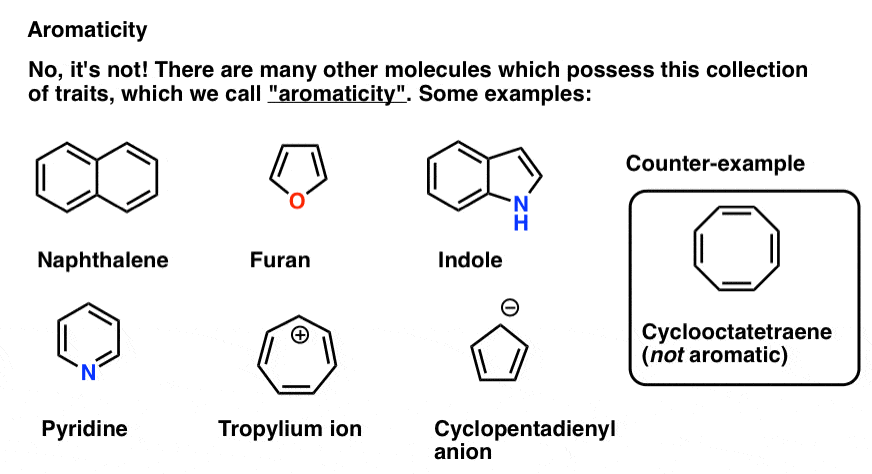
There’s even molecules entirely lacking in carbon which have some properties of aromaticity (borazine). The bases of DNA (adenine, cytosine, guanine, thymine) have aromatic character.
However, molecules are not aromatic simply by virtue of being cyclic and having double bonds at the perimeter. Cyclooctatetraene (above right) is not aromatic, and behaves like a normal conjugated alkene.
It’s enough to make you scratch your head.
8. So What Makes A Molecule Aromatic?
So why is benzene aromatic, but cyclooctatetraene is not? How can we tell if a molecule is aromatic? What are the rules?
Great, great question. But we’ve run out of time to answer that today. More on that in the next post. See next: Rules For Aromaticity
Thanks to Matt Knowe for assistance with writing this post.
Notes
Related Articles
- Rules For Aromaticity
- Huckel’s Rule: What Does 4n+2 Mean?
- “Is This Molecule Aromatic?” Some Practice Problems
- Conjugation And Resonance In Organic Chemistry
- Ortho-, Para- and Meta- Directors in Electrophilic Aromatic Substitution
- Markovnikov Addition Of HCl To Alkenes
- Alkene Addition Pattern #3: The “Concerted” Pathway
Note 1. 36 kcal/mol is a huge deal in energy terms. A C-C pi bond is worth about 60 kcal/mol, so the energy stabilization of aromaticity is worth about half that number.
Even 3 kcal/mol difference between two compounds in equilibrium will result in about a 99:1 distribution towards the more stable component (remember cyclohexane chair A-values?)
Note 2. There’s a fourth diagnostic property of aromaticity – ring currents – which is observed in an applied magnetic field, such as when obtaining nuclear magnetic resonance (NMR) spectra. There’s no need to get into this right now, so it will get no further comment
(Advanced) References and Further Reading
- Sur la constitution des substances aromatiques
A. Kekulé
Bull. Soc. Chim. Fr. 1865, 3, 98–110
LINK
Kekulé’s famous paper on the structure of benzene and aromatic compounds, in French. - Zur Constitution des Benzols
Ladenburg
Just. Lieb. Ann. Chem. 1874, 172 (3), 331-356
DOI: 10.1002/jlac.18741720314
Ladenburg proved all 6 positions of benzene were equivalent (this paper is in German). - Ueber die Constitution des Benzols. Ueber die Hexahydroisophtalsäure
Adolf Baeyer, Victor Villiger
Lieb. Ann. Chem. 1893, 276 (3), 255-265
DOI: 10.1002/jlac.18932760302
This paper is by the same Adolf von Baeyer and Victor Villiger of Baeyer-Villiger reaction fame. Here, they describe the reduction of various benzene derivatives to cyclohexadiene, cyclohexene or cyclohexane compounds and determined the constitutions by standard methods. They also disproved a prism structure for benzene (this paper is in German). - Zur Kenntniss der ungesättigten Verbindungen. Theorie der ungesättigten und aromatischen Verbindungen
Johannes Thiele
Lieb. Ann. Chem. 1899, 306 (1-2), 87-142
DOI: 10.1002/jlac.18993060107
Thiele was the first person to discuss “conjugation” between double bonds, and potentially might have been the first to draw benzene with a circle in the middle (this is in German). - The structure of the benzene ring in C6(CH3)6
Kathleen Lonsdale
Proc. Royal Soc. A 1929, 123 (792), 494-515
DOI: 10.1098/rspa.1929.0081
Paper that describes the X-ray structure of hexamethylbenzene, showing that all the aromatic C-C bonds are the same length, 1.42 Å. - The Nature of the Chemical Bond. VI. The Calculation from Thermochemical Data of the Energy of Resonance of Molecules Among Several Electronic Structures
Linus Pauling and J. Sherman
J. Chem. Phys. 1933, 1, 606
DOI: 10.1063/1.1749335
This paper is the origin of the term ‘resonance energy’. - Heats of Organic Reactions. IV. Hydrogenation of Some Dienes and of Benzene
B. Kistiakowsky, John R. Ruhoff, Hilton A. Smith, and W. E. Vaughan
Journal of the American Chemical Society 1936, 58 (1), 146-153
DOI: 10.1021/ja01292a043
The commonly cited value of 49.8 kcal/mol for the complete hydrogenation of benzene is from this paper. - The use of 90°-1,3-butadiene as a reference structure for the evaluation of stabilization energies for benzene and other conjugated cyclic hydrocarbons
Philip George, Mendel Trachtman, Charles W. Bock, Alistair M. Brett
Tetrahedron 1976, 32 (12), 1357-1362
DOI: 1016/0040-4020(76)85010-7
The isodesmic reaction approach has been applied to the calculation of the resonance stabilization of benzene. This approach can be taken using either experimental thermochemical data or energies obtained by MO calculations. If the resonance energy of butadiene is assigned as zero, then the resonance energy of benzene would be 21.2 kcal/mol. If butadiene is considered to have a delocalization energy, the calculation must be modified to reflect that fact. Using 7.2 kcal/mol as the butadiene delocalization energy gives a value of 42.8 kcal/mol as the benzene resonance energy. - Quantentheoretische Beiträge zum Benzolproblem
Die Elektronenkonfiguration des Benzols und verwandter Verbindungen
Erich Hückel
Zeitschrift für Physik 1931, 70, 204–286
DOI: 10.1007/BF01339530
Erich Hückel achieved recognition by elaborating, together with Peter Debye, the theory of strong electrolytes in 1923 and later by applying a simplified version of quantum theory to p-electrons in conjugated molecules, which became known as Hückel molecular orbital (HMO) theory. Although he never explicitly formulated a “4n + 2 rule”, this was obvious from his work. Hückel showed that monocyclic systems with continuous conjugation having 6, 10, 14, etc. p-electrons benefited from extra stabilization and were aromatic. But it is more accurate to refer to the “Hückel 4n + 2 p-electron rule,” rather than to “Hückel’s rule.” - Nucleus-Independent Chemical Shifts: A Simple and Efficient Aromaticity Probe
Paul von Ragué Schleyer, Christoph Maerker, Alk Dransfeld, Haijun Jiao, and Nicolaas J. R. van Eikema Hommes
Journal of the American Chemical Society 1996, 118 (26), 6317-6318
DOI: 10.1021/ja960582d
This paper is an advanced topic but worth including here, as it is one of Prof. Schleyer’s most highly cited papers. Aromaticity is a difficult concept to accurately define, but one way to empirically measure it is to use computational methods. Here, Prof. Schleyer describes the “NICS effect” as a method of measuring aromaticity, based on magnetic susceptibility exaltation. Aromatic compounds have a ‘ring current’ due to the conjugation of the p orbitals and the presence of delocalized p electrons, and are therefore diamagnetic. This can be measured experimentally or probed computationally. - Aromaticity Today: Energetic and Structural Criteria
Mikhail Glukhovtsev
Journal of Chemical Education 1997, 74 (1), 132
DOI: 1021/ed074p132
This paper discusses two of the criteria for establishing aromaticity – planarity and a positive stabilization energy. The latter can be verified by computational methods, as the article demonstrates.
00 General Chemistry Review
01 Bonding, Structure, and Resonance
- How Do We Know Methane (CH4) Is Tetrahedral?
- Hybrid Orbitals and Hybridization
- How To Determine Hybridization: A Shortcut
- Orbital Hybridization And Bond Strengths
- Sigma bonds come in six varieties: Pi bonds come in one
- A Key Skill: How to Calculate Formal Charge
- The Four Intermolecular Forces and How They Affect Boiling Points
- 3 Trends That Affect Boiling Points
- How To Use Electronegativity To Determine Electron Density (and why NOT to trust formal charge)
- Introduction to Resonance
- How To Use Curved Arrows To Interchange Resonance Forms
- Evaluating Resonance Forms (1) - The Rule of Least Charges
- How To Find The Best Resonance Structure By Applying Electronegativity
- Evaluating Resonance Structures With Negative Charges
- Evaluating Resonance Structures With Positive Charge
- Exploring Resonance: Pi-Donation
- Exploring Resonance: Pi-acceptors
- In Summary: Evaluating Resonance Structures
- Drawing Resonance Structures: 3 Common Mistakes To Avoid
- How to apply electronegativity and resonance to understand reactivity
- Bond Hybridization Practice
- Structure and Bonding Practice Quizzes
- Resonance Structures Practice
02 Acid Base Reactions
- Introduction to Acid-Base Reactions
- Acid Base Reactions In Organic Chemistry
- The Stronger The Acid, The Weaker The Conjugate Base
- Walkthrough of Acid-Base Reactions (3) - Acidity Trends
- Five Key Factors That Influence Acidity
- Acid-Base Reactions: Introducing Ka and pKa
- How to Use a pKa Table
- The pKa Table Is Your Friend
- A Handy Rule of Thumb for Acid-Base Reactions
- Acid Base Reactions Are Fast
- pKa Values Span 60 Orders Of Magnitude
- How Protonation and Deprotonation Affect Reactivity
- Acid Base Practice Problems
03 Alkanes and Nomenclature
- Meet the (Most Important) Functional Groups
- Condensed Formulas: Deciphering What the Brackets Mean
- Hidden Hydrogens, Hidden Lone Pairs, Hidden Counterions
- Don't Be Futyl, Learn The Butyls
- Primary, Secondary, Tertiary, Quaternary In Organic Chemistry
- Branching, and Its Affect On Melting and Boiling Points
- The Many, Many Ways of Drawing Butane
- Wedge And Dash Convention For Tetrahedral Carbon
- Common Mistakes in Organic Chemistry: Pentavalent Carbon
- Table of Functional Group Priorities for Nomenclature
- Summary Sheet - Alkane Nomenclature
- Organic Chemistry IUPAC Nomenclature Demystified With A Simple Puzzle Piece Approach
- Boiling Point Quizzes
- Organic Chemistry Nomenclature Quizzes
04 Conformations and Cycloalkanes
- Staggered vs Eclipsed Conformations of Ethane
- Conformational Isomers of Propane
- Newman Projection of Butane (and Gauche Conformation)
- Introduction to Cycloalkanes
- Geometric Isomers In Small Rings: Cis And Trans Cycloalkanes
- Calculation of Ring Strain In Cycloalkanes
- Cycloalkanes - Ring Strain In Cyclopropane And Cyclobutane
- Cyclohexane Conformations
- Cyclohexane Chair Conformation: An Aerial Tour
- How To Draw The Cyclohexane Chair Conformation
- The Cyclohexane Chair Flip
- The Cyclohexane Chair Flip - Energy Diagram
- Substituted Cyclohexanes - Axial vs Equatorial
- Ranking The Bulkiness Of Substituents On Cyclohexanes: "A-Values"
- Cyclohexane Chair Conformation Stability: Which One Is Lower Energy?
- Fused Rings - Cis-Decalin and Trans-Decalin
- Naming Bicyclic Compounds - Fused, Bridged, and Spiro
- Bredt's Rule (And Summary of Cycloalkanes)
- Newman Projection Practice
- Cycloalkanes Practice Problems
05 A Primer On Organic Reactions
- The Most Important Question To Ask When Learning a New Reaction
- Learning New Reactions: How Do The Electrons Move?
- The Third Most Important Question to Ask When Learning A New Reaction
- 7 Factors that stabilize negative charge in organic chemistry
- 7 Factors That Stabilize Positive Charge in Organic Chemistry
- Nucleophiles and Electrophiles
- Curved Arrows (for reactions)
- Curved Arrows (2): Initial Tails and Final Heads
- Nucleophilicity vs. Basicity
- The Three Classes of Nucleophiles
- What Makes A Good Nucleophile?
- What makes a good leaving group?
- 3 Factors That Stabilize Carbocations
- Equilibrium and Energy Relationships
- What's a Transition State?
- Hammond's Postulate
- Learning Organic Chemistry Reactions: A Checklist (PDF)
- Introduction to Free Radical Substitution Reactions
- Introduction to Oxidative Cleavage Reactions
06 Free Radical Reactions
- Bond Dissociation Energies = Homolytic Cleavage
- Free Radical Reactions
- 3 Factors That Stabilize Free Radicals
- What Factors Destabilize Free Radicals?
- Bond Strengths And Radical Stability
- Free Radical Initiation: Why Is "Light" Or "Heat" Required?
- Initiation, Propagation, Termination
- Monochlorination Products Of Propane, Pentane, And Other Alkanes
- Selectivity In Free Radical Reactions
- Selectivity in Free Radical Reactions: Bromination vs. Chlorination
- Halogenation At Tiffany's
- Allylic Bromination
- Bonus Topic: Allylic Rearrangements
- In Summary: Free Radicals
- Synthesis (2) - Reactions of Alkanes
- Free Radicals Practice Quizzes
07 Stereochemistry and Chirality
- Types of Isomers: Constitutional Isomers, Stereoisomers, Enantiomers, and Diastereomers
- How To Draw The Enantiomer Of A Chiral Molecule
- How To Draw A Bond Rotation
- Introduction to Assigning (R) and (S): The Cahn-Ingold-Prelog Rules
- Assigning Cahn-Ingold-Prelog (CIP) Priorities (2) - The Method of Dots
- Enantiomers vs Diastereomers vs The Same? Two Methods For Solving Problems
- Assigning R/S To Newman Projections (And Converting Newman To Line Diagrams)
- How To Determine R and S Configurations On A Fischer Projection
- The Meso Trap
- Optical Rotation, Optical Activity, and Specific Rotation
- Optical Purity and Enantiomeric Excess
- What's a Racemic Mixture?
- Chiral Allenes And Chiral Axes
- Stereochemistry Practice Problems and Quizzes
08 Substitution Reactions
- Nucleophilic Substitution Reactions - Introduction
- Two Types of Nucleophilic Substitution Reactions
- The SN2 Mechanism
- Why the SN2 Reaction Is Powerful
- The SN1 Mechanism
- The Conjugate Acid Is A Better Leaving Group
- Comparing the SN1 and SN2 Reactions
- Polar Protic? Polar Aprotic? Nonpolar? All About Solvents
- Steric Hindrance is Like a Fat Goalie
- Common Blind Spot: Intramolecular Reactions
- Substitution Practice - SN1
- Substitution Practice - SN2
09 Elimination Reactions
- Elimination Reactions (1): Introduction And The Key Pattern
- Elimination Reactions (2): The Zaitsev Rule
- Elimination Reactions Are Favored By Heat
- Two Elimination Reaction Patterns
- The E1 Reaction
- The E2 Mechanism
- E1 vs E2: Comparing the E1 and E2 Reactions
- Antiperiplanar Relationships: The E2 Reaction and Cyclohexane Rings
- Bulky Bases in Elimination Reactions
- Comparing the E1 vs SN1 Reactions
- Elimination (E1) Reactions With Rearrangements
- E1cB - Elimination (Unimolecular) Conjugate Base
- Elimination (E1) Practice Problems And Solutions
- Elimination (E2) Practice Problems and Solutions
10 Rearrangements
11 SN1/SN2/E1/E2 Decision
- Identifying Where Substitution and Elimination Reactions Happen
- Deciding SN1/SN2/E1/E2 (1) - The Substrate
- Deciding SN1/SN2/E1/E2 (2) - The Nucleophile/Base
- SN1 vs E1 and SN2 vs E2 : The Temperature
- Deciding SN1/SN2/E1/E2 - The Solvent
- Wrapup: The Key Factors For Determining SN1/SN2/E1/E2
- Alkyl Halide Reaction Map And Summary
- SN1 SN2 E1 E2 Practice Problems
12 Alkene Reactions
- E and Z Notation For Alkenes (+ Cis/Trans)
- Alkene Stability
- Alkene Addition Reactions: "Regioselectivity" and "Stereoselectivity" (Syn/Anti)
- Stereoselective and Stereospecific Reactions
- Hydrohalogenation of Alkenes and Markovnikov's Rule
- Hydration of Alkenes With Aqueous Acid
- Rearrangements in Alkene Addition Reactions
- Halogenation of Alkenes and Halohydrin Formation
- Oxymercuration Demercuration of Alkenes
- Hydroboration Oxidation of Alkenes
- m-CPBA (meta-chloroperoxybenzoic acid)
- OsO4 (Osmium Tetroxide) for Dihydroxylation of Alkenes
- Palladium on Carbon (Pd/C) for Catalytic Hydrogenation of Alkenes
- Cyclopropanation of Alkenes
- A Fourth Alkene Addition Pattern - Free Radical Addition
- Alkene Reactions: Ozonolysis
- Summary: Three Key Families Of Alkene Reaction Mechanisms
- Synthesis (4) - Alkene Reaction Map, Including Alkyl Halide Reactions
- Alkene Reactions Practice Problems
13 Alkyne Reactions
- Acetylides from Alkynes, And Substitution Reactions of Acetylides
- Partial Reduction of Alkynes With Lindlar's Catalyst
- Partial Reduction of Alkynes With Na/NH3 To Obtain Trans Alkenes
- Alkyne Hydroboration With "R2BH"
- Hydration and Oxymercuration of Alkynes
- Hydrohalogenation of Alkynes
- Alkyne Halogenation: Bromination, Chlorination, and Iodination of Alkynes
- Alkyne Reactions - The "Concerted" Pathway
- Alkenes To Alkynes Via Halogenation And Elimination Reactions
- Alkynes Are A Blank Canvas
- Synthesis (5) - Reactions of Alkynes
- Alkyne Reactions Practice Problems With Answers
14 Alcohols, Epoxides and Ethers
- Alcohols - Nomenclature and Properties
- Alcohols Can Act As Acids Or Bases (And Why It Matters)
- Alcohols - Acidity and Basicity
- The Williamson Ether Synthesis
- Ethers From Alkenes, Tertiary Alkyl Halides and Alkoxymercuration
- Alcohols To Ethers via Acid Catalysis
- Cleavage Of Ethers With Acid
- Epoxides - The Outlier Of The Ether Family
- Opening of Epoxides With Acid
- Epoxide Ring Opening With Base
- Making Alkyl Halides From Alcohols
- Tosylates And Mesylates
- PBr3 and SOCl2
- Elimination Reactions of Alcohols
- Elimination of Alcohols To Alkenes With POCl3
- Alcohol Oxidation: "Strong" and "Weak" Oxidants
- Demystifying The Mechanisms of Alcohol Oxidations
- Protecting Groups For Alcohols
- Thiols And Thioethers
- Calculating the oxidation state of a carbon
- Oxidation and Reduction in Organic Chemistry
- Oxidation Ladders
- SOCl2 Mechanism For Alcohols To Alkyl Halides: SN2 versus SNi
- Alcohol Reactions Roadmap (PDF)
- Alcohol Reaction Practice Problems
- Epoxide Reaction Quizzes
- Oxidation and Reduction Practice Quizzes
15 Organometallics
- What's An Organometallic?
- Formation of Grignard and Organolithium Reagents
- Organometallics Are Strong Bases
- Reactions of Grignard Reagents
- Protecting Groups In Grignard Reactions
- Synthesis Problems Involving Grignard Reagents
- Grignard Reactions And Synthesis (2)
- Organocuprates (Gilman Reagents): How They're Made
- Gilman Reagents (Organocuprates): What They're Used For
- The Heck, Suzuki, and Olefin Metathesis Reactions (And Why They Don't Belong In Most Introductory Organic Chemistry Courses)
- Reaction Map: Reactions of Organometallics
- Grignard Practice Problems
16 Spectroscopy
- Degrees of Unsaturation (or IHD, Index of Hydrogen Deficiency)
- Conjugation And Color (+ How Bleach Works)
- Introduction To UV-Vis Spectroscopy
- UV-Vis Spectroscopy: Absorbance of Carbonyls
- UV-Vis Spectroscopy: Practice Questions
- Bond Vibrations, Infrared Spectroscopy, and the "Ball and Spring" Model
- Infrared Spectroscopy: A Quick Primer On Interpreting Spectra
- IR Spectroscopy: 4 Practice Problems
- 1H NMR: How Many Signals?
- Homotopic, Enantiotopic, Diastereotopic
- Diastereotopic Protons in 1H NMR Spectroscopy: Examples
- C13 NMR - How Many Signals
- Liquid Gold: Pheromones In Doe Urine
- Natural Product Isolation (1) - Extraction
- Natural Product Isolation (2) - Purification Techniques, An Overview
- Structure Determination Case Study: Deer Tarsal Gland Pheromone
17 Dienes and MO Theory
- What To Expect In Organic Chemistry 2
- Are these molecules conjugated?
- Conjugation And Resonance In Organic Chemistry
- Bonding And Antibonding Pi Orbitals
- Molecular Orbitals of The Allyl Cation, Allyl Radical, and Allyl Anion
- Pi Molecular Orbitals of Butadiene
- Reactions of Dienes: 1,2 and 1,4 Addition
- Thermodynamic and Kinetic Products
- More On 1,2 and 1,4 Additions To Dienes
- s-cis and s-trans
- The Diels-Alder Reaction
- Cyclic Dienes and Dienophiles in the Diels-Alder Reaction
- Stereochemistry of the Diels-Alder Reaction
- Exo vs Endo Products In The Diels Alder: How To Tell Them Apart
- HOMO and LUMO In the Diels Alder Reaction
- Why Are Endo vs Exo Products Favored in the Diels-Alder Reaction?
- Diels-Alder Reaction: Kinetic and Thermodynamic Control
- The Retro Diels-Alder Reaction
- The Intramolecular Diels Alder Reaction
- Regiochemistry In The Diels-Alder Reaction
- The Cope and Claisen Rearrangements
- Electrocyclic Reactions
- Electrocyclic Ring Opening And Closure (2) - Six (or Eight) Pi Electrons
- Diels Alder Practice Problems
- Molecular Orbital Theory Practice
18 Aromaticity
- Introduction To Aromaticity
- Rules For Aromaticity
- Huckel's Rule: What Does 4n+2 Mean?
- Aromatic, Non-Aromatic, or Antiaromatic? Some Practice Problems
- Antiaromatic Compounds and Antiaromaticity
- The Pi Molecular Orbitals of Benzene
- The Pi Molecular Orbitals of Cyclobutadiene
- Frost Circles
- Aromaticity Practice Quizzes
19 Reactions of Aromatic Molecules
- Electrophilic Aromatic Substitution: Introduction
- Activating and Deactivating Groups In Electrophilic Aromatic Substitution
- Electrophilic Aromatic Substitution - The Mechanism
- Ortho-, Para- and Meta- Directors in Electrophilic Aromatic Substitution
- Understanding Ortho, Para, and Meta Directors
- Why are halogens ortho- para- directors?
- Disubstituted Benzenes: The Strongest Electron-Donor "Wins"
- Electrophilic Aromatic Substitutions (1) - Halogenation of Benzene
- Electrophilic Aromatic Substitutions (2) - Nitration and Sulfonation
- EAS Reactions (3) - Friedel-Crafts Acylation and Friedel-Crafts Alkylation
- Intramolecular Friedel-Crafts Reactions
- Nucleophilic Aromatic Substitution (NAS)
- Nucleophilic Aromatic Substitution (2) - The Benzyne Mechanism
- Reactions on the "Benzylic" Carbon: Bromination And Oxidation
- The Wolff-Kishner, Clemmensen, And Other Carbonyl Reductions
- More Reactions on the Aromatic Sidechain: Reduction of Nitro Groups and the Baeyer Villiger
- Aromatic Synthesis (1) - "Order Of Operations"
- Synthesis of Benzene Derivatives (2) - Polarity Reversal
- Aromatic Synthesis (3) - Sulfonyl Blocking Groups
- Birch Reduction
- Synthesis (7): Reaction Map of Benzene and Related Aromatic Compounds
- Aromatic Reactions and Synthesis Practice
- Electrophilic Aromatic Substitution Practice Problems
20 Aldehydes and Ketones
- What's The Alpha Carbon In Carbonyl Compounds?
- Nucleophilic Addition To Carbonyls
- Aldehydes and Ketones: 14 Reactions With The Same Mechanism
- Sodium Borohydride (NaBH4) Reduction of Aldehydes and Ketones
- Grignard Reagents For Addition To Aldehydes and Ketones
- Wittig Reaction
- Hydrates, Hemiacetals, and Acetals
- Imines - Properties, Formation, Reactions, and Mechanisms
- All About Enamines
- Breaking Down Carbonyl Reaction Mechanisms: Reactions of Anionic Nucleophiles (Part 2)
- Aldehydes Ketones Reaction Practice
21 Carboxylic Acid Derivatives
- Nucleophilic Acyl Substitution (With Negatively Charged Nucleophiles)
- Addition-Elimination Mechanisms With Neutral Nucleophiles (Including Acid Catalysis)
- Basic Hydrolysis of Esters - Saponification
- Transesterification
- Proton Transfer
- Fischer Esterification - Carboxylic Acid to Ester Under Acidic Conditions
- Lithium Aluminum Hydride (LiAlH4) For Reduction of Carboxylic Acid Derivatives
- LiAlH[Ot-Bu]3 For The Reduction of Acid Halides To Aldehydes
- Di-isobutyl Aluminum Hydride (DIBAL) For The Partial Reduction of Esters and Nitriles
- Amide Hydrolysis
- Thionyl Chloride (SOCl2)
- Diazomethane (CH2N2)
- Carbonyl Chemistry: Learn Six Mechanisms For the Price Of One
- Making Music With Mechanisms (PADPED)
- Carboxylic Acid Derivatives Practice Questions
22 Enols and Enolates
- Keto-Enol Tautomerism
- Enolates - Formation, Stability, and Simple Reactions
- Kinetic Versus Thermodynamic Enolates
- Aldol Addition and Condensation Reactions
- Reactions of Enols - Acid-Catalyzed Aldol, Halogenation, and Mannich Reactions
- Claisen Condensation and Dieckmann Condensation
- Decarboxylation
- The Malonic Ester and Acetoacetic Ester Synthesis
- The Michael Addition Reaction and Conjugate Addition
- The Robinson Annulation
- Haloform Reaction
- The Hell–Volhard–Zelinsky Reaction
- Enols and Enolates Practice Quizzes
23 Amines
- The Amide Functional Group: Properties, Synthesis, and Nomenclature
- Basicity of Amines And pKaH
- 5 Key Basicity Trends of Amines
- The Mesomeric Effect And Aromatic Amines
- Nucleophilicity of Amines
- Alkylation of Amines (Sucks!)
- Reductive Amination
- The Gabriel Synthesis
- Some Reactions of Azides
- The Hofmann Elimination
- The Hofmann and Curtius Rearrangements
- The Cope Elimination
- Protecting Groups for Amines - Carbamates
- The Strecker Synthesis of Amino Acids
- Introduction to Peptide Synthesis
- Reactions of Diazonium Salts: Sandmeyer and Related Reactions
- Amine Practice Questions
24 Carbohydrates
- D and L Notation For Sugars
- Pyranoses and Furanoses: Ring-Chain Tautomerism In Sugars
- What is Mutarotation?
- Reducing Sugars
- The Big Damn Post Of Carbohydrate-Related Chemistry Definitions
- The Haworth Projection
- Converting a Fischer Projection To A Haworth (And Vice Versa)
- Reactions of Sugars: Glycosylation and Protection
- The Ruff Degradation and Kiliani-Fischer Synthesis
- Isoelectric Points of Amino Acids (and How To Calculate Them)
- Carbohydrates Practice
- Amino Acid Quizzes
25 Fun and Miscellaneous
- A Gallery of Some Interesting Molecules From Nature
- Screw Organic Chemistry, I'm Just Going To Write About Cats
- On Cats, Part 1: Conformations and Configurations
- On Cats, Part 2: Cat Line Diagrams
- On Cats, Part 4: Enantiocats
- On Cats, Part 6: Stereocenters
- Organic Chemistry Is Shit
- The Organic Chemistry Behind "The Pill"
- Maybe they should call them, "Formal Wins" ?
- Why Do Organic Chemists Use Kilocalories?
- The Principle of Least Effort
- Organic Chemistry GIFS - Resonance Forms
- Reproducibility In Organic Chemistry
- What Holds The Nucleus Together?
- How Reactions Are Like Music
- Organic Chemistry and the New MCAT
26 Organic Chemistry Tips and Tricks
- Common Mistakes: Formal Charges Can Mislead
- Partial Charges Give Clues About Electron Flow
- Draw The Ugly Version First
- Organic Chemistry Study Tips: Learn the Trends
- The 8 Types of Arrows In Organic Chemistry, Explained
- Top 10 Skills To Master Before An Organic Chemistry 2 Final
- Common Mistakes with Carbonyls: Carboxylic Acids... Are Acids!
- Planning Organic Synthesis With "Reaction Maps"
- Alkene Addition Pattern #1: The "Carbocation Pathway"
- Alkene Addition Pattern #2: The "Three-Membered Ring" Pathway
- Alkene Addition Pattern #3: The "Concerted" Pathway
- Number Your Carbons!
- The 4 Major Classes of Reactions in Org 1
- How (and why) electrons flow
- Grossman's Rule
- Three Exam Tips
- A 3-Step Method For Thinking Through Synthesis Problems
- Putting It Together
- Putting Diels-Alder Products in Perspective
- The Ups and Downs of Cyclohexanes
- The Most Annoying Exceptions in Org 1 (Part 1)
- The Most Annoying Exceptions in Org 1 (Part 2)
- The Marriage May Be Bad, But the Divorce Still Costs Money
- 9 Nomenclature Conventions To Know
- Nucleophile attacks Electrophile
27 Case Studies of Successful O-Chem Students
- Success Stories: How Corina Got The The "Hard" Professor - And Got An A+ Anyway
- How Helena Aced Organic Chemistry
- From a "Drop" To B+ in Org 2 – How A Hard Working Student Turned It Around
- How Serge Aced Organic Chemistry
- Success Stories: How Zach Aced Organic Chemistry 1
- Success Stories: How Kari Went From C– to B+
- How Esther Bounced Back From a "C" To Get A's In Organic Chemistry 1 And 2
- How Tyrell Got The Highest Grade In Her Organic Chemistry Course
- This Is Why Students Use Flashcards
- Success Stories: How Stu Aced Organic Chemistry
- How John Pulled Up His Organic Chemistry Exam Grades
- Success Stories: How Nathan Aced Organic Chemistry (Without It Taking Over His Life)
- How Chris Aced Org 1 and Org 2
- Interview: How Jay Got an A+ In Organic Chemistry
- How to Do Well in Organic Chemistry: One Student's Advice
- "America's Top TA" Shares His Secrets For Teaching O-Chem
- "Organic Chemistry Is Like..." - A Few Metaphors
- How To Do Well In Organic Chemistry: Advice From A Tutor
- Guest post: "I went from being afraid of tests to actually looking forward to them".
Excellent notes I am wayy behind in advanced organic chemistry class and i feel a lot better reading this along with my lecture notes. I am understanding a lot of simple concepts essential to understanding harder things.
That’s the goal. Thanks for stopping by Davion!
Here i coupling 2-flouru-5-hydroxy benzaldehyde and 4-flouro- benzonitrile presence of k2co3 in dmf as solvent at 95-100 degree. Reaction is not going upto 90% just 70% going then remain 30% dimer impurity forming, here what i need no need to formation of dimer is there any suggestions please
For such a specialized questions you may want to access the collective wisdom of many different people. I suggest asking this question on a forum such as this one:
http://www.chemicalforums.com/index.php?board=35.0
That’s a forum for graduate students, and others, seeking help with synthesis.